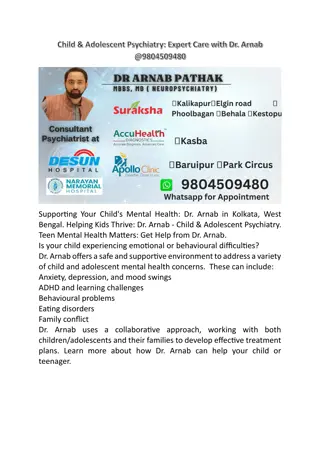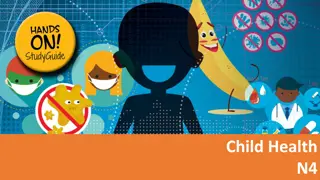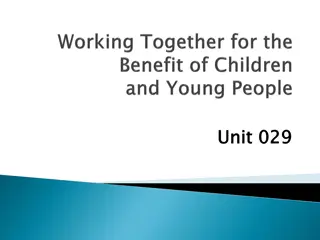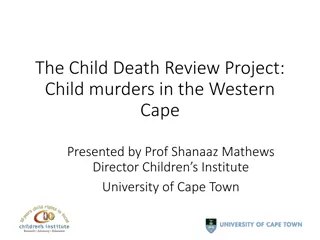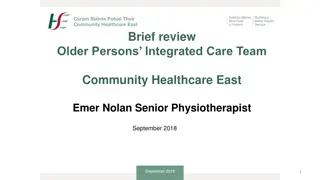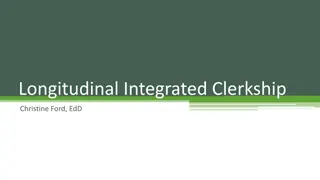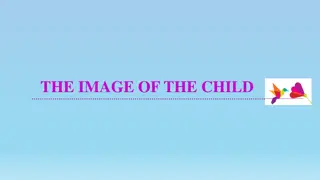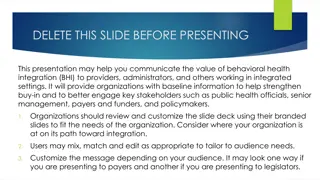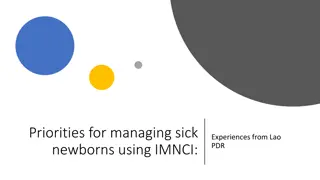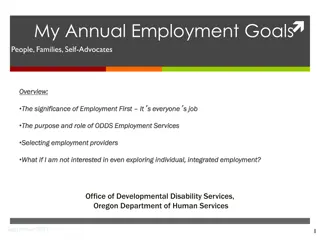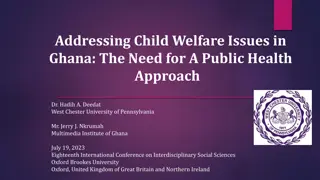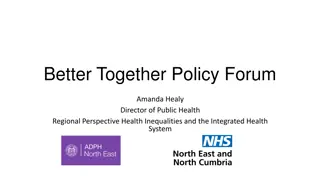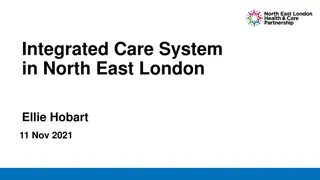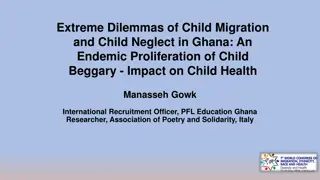Comprehensive Overview of IMNCI - Integrated Approach to Child Health
IMNCI is an integrated approach to child health focusing on common causes of child mortality like diarrhea, pneumonia, measles, malaria, and malnutrition. Developed to address child health in developing countries, IMNCI aims to reduce under-five mortality rates through preventive and curative measures for children aged 1 week to 5 years. Key components include care for infants and young children, assessing child survival indicators, determining prevalence of illnesses, and evaluating program coverage. The strategy emphasizes holistic child well-being and aims to improve child health outcomes in vulnerable populations.
Download Presentation

Please find below an Image/Link to download the presentation.
The content on the website is provided AS IS for your information and personal use only. It may not be sold, licensed, or shared on other websites without obtaining consent from the author. Download presentation by click this link. If you encounter any issues during the download, it is possible that the publisher has removed the file from their server.
E N D
Presentation Transcript
objective INTRODUCE THE IMNCI. DEFINE THE IMNCI. DEVELOPMENTS RELATED TO CHILD HEALTH OF IMNCI. BENEFICIAL OF IMNCI. GOAL OF IMNCI. OBJECTIVE OF IMNCI. COMPONENT OF IMNCI. PRINCIPALS OF IMNCI. PROICESS OF IMNCI.
INTRODUCTION Every year about 9 million children in developing countries die before they reach their fifth birthday, many of them during the first year of life. Ethiopia has one of the highest under-five mortality rates with more than 321,000 children under the age of five dying every year. More than 70% of these child deaths are due to five diseases, namely pneumonia, diarrhoea, malaria, measles and malnutrition, and often to a combination of these conditions.
DEFINITION IMNCI is an integrated approach to child health that focuses on the well being of the whole child. It focussed primarily on the most common causes of child mortality- diarrhea, pneumonia, measles ,malaria, and malnutrition, illness affecting children aged 1 week 2 months, 2 months -5 year including both preventive and curative elements to be implemented by families.
Developments Related To Child Health 1978: EPI 1984: UIP 1985: Oral Rehydration Therapy1 1990: UIP and ORT universalized, 1992: CSSM 1997: RCH-1 2005: NRHM and RCH II
BENEFICIAL care of young infants for new born(under 2months) young children(2months-5yrs)
GOAL To assess current statues of child survival indicators and process indicators for existing programme activities in intervention and compassion districts.
OBJECTIVE To determine baseline mortality among children under 5yrs of age(NMR,IMR,) To determine prevalence of fever, loose stools ,cough and any other illness(morbidity density)in two weeks prior to day of field survey among children under 5yrs of age. To assess effective programme coverage for specified disease condition(cough with fast breathing)occurring in two weeks prior to day of field survey.
COMPONENT The IMNCI strategy includes both preventive and curative interventions that aim to improve practices in health facilities, the health system and at home. At the core of the strategy is integrated case management of the most common neonatal and childhood problems with a focus on the most common causes of death.
CONTI.. STRATEGY INCLUDES THREE MAIN COMPONENTS STRATEGY INCLUDES THREE MAIN COMPONENTS- - Improvements in the case-management skills of health staff through the provision of locally- adapted guidelines on Integrated Management of Neonatal and Childhood Illness and activities to promote their use. Improvements in the overall health system required for effective management of neonatal and childhood illness. Improvements in family and community health care practices.
PRINCIPle Depending on a child s age, various clinical signs and symptoms differ in their degrees of reliability and diagnostic value and importance. Therefore, the IMNCI guidelines recommend case management procedures based on two age categories: Young infants age up to 2 months. Children age 2 months up to 5 years 8 All sick young infants up to 2 months of age must be assessed for possible bacterial infection / jaundice . Then they must be routinely assessed for the major symptom diarrhoea .
CONTI All sick children age 2 months up to 5 years must be examined for general danger signs which indicate the need for immediate referral or admission to a hospital. They must then be routinely assessed for major symptoms: cough or difficult breathing, diarrhoea, fever and ear problems. All sick young infants and children 2 months up to 5 years must also be routinely assessed for nutritional and immunization status, feeding problems, and other potential problems. Only a limited number of carefully selected clinical signs are used, based on evidence of their sensitivity and specificity to detect disease. These signs were selected considering the conditions and realities of first-level health facilities.
PROCESS OF IMNCI
CARE OF CHILDREN ACCORDINGTO IMNCI 0-2MONTHS- keeping the child warm. Intiation of breast feeding. counselling for exclusive breast feeding cord,skin and eye care. recognition of illness in newborn and managementand/referral. Immunisation home visit in the post natal period.
2MONTHS-5YRS Management of diarrhea, ARI, malaria, measles ,acute ear infection ,malnutrition and anemia. Recognition of illness and risk. Prevention and management of iron and vitaminAdeficiency Counselling on feeding for all chilkdren below 2yrs. Counselling on feeding for malnutrished Immunization
TEACHING & COUNSELING Teach mother to keep infant warm. Teach correct position for breast feeding Advice on home care of young infant Advice mother to return immediately if danger signs present
Vit A Prophylaxis- 9 months -1 lakh unit. 16-36 months -2 lakh unit.
FEEDING RECOMMENDATION 0-6months-Breast feed as often as child want, Do not give any other food, Continue breast feeding if child is sick 6-12months-Breast feed as often, Give smashed roti, rice, bread, biscuit, milk or vegetables, Keep child on your lap, Wash child's hand before feeding 1-2yrs-Breast feed as often, Offer family food, Sit by the side of child, Wash hands with soap 2yrs-Give family food, Ensure that child finishes the serving,Teach child to wash hands
summary Implementation of the IMNCI resulted in substantial improvement in infant survival and in neonatal survival in those born at home. The IMNCI should be a part of India s strategy to achieve the millennium development goal on child survival.
bibliography Ghai, O.P. (2008).Ghai essentials of paediatrics.(ed.6th).Delhi. O.P Ghai publishers. Gupta,P.(2004).Essentials of paediatric nursing.(ed.1st).New Delhi:A.P Jain &Co Publishers. Marlow.& Redding.(2008).Text nursing.(ed.6th).Philadelphia: 57,58 Wong, D.L& Hockenberry.(2001).Wong s paediatric nursing.(ed.7th).Missouri: Mosby publications Parul Dutta, Paediatric nursing 2nd. edition P.No.23 book of paediatric Elsevier publications.P.NO.- essentials of



